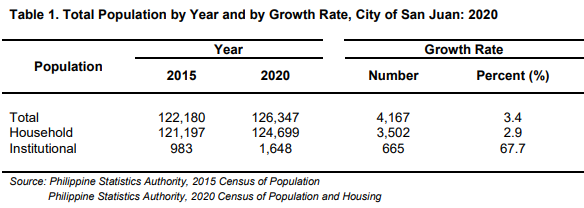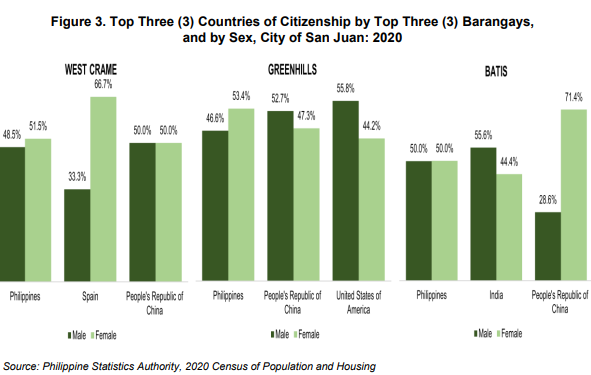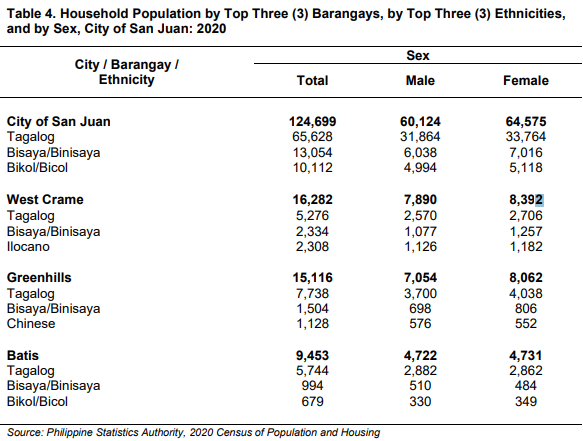Amidst the pandemic, San Juan manages to reach a 3.4 percent increase in 2020
The population in the City of San Juan continues to rise each year. From 122,180 in 2015, the total population of San Juaneños increased by 3.4 percent (4,167 persons) reaching 126,347 over five (5) years. (See Table 1)
Of this total, 124,699 comprised the household population while the remaining 1,648 belonged to the institutional population. (See Table 1)
Additionally, 51.8 percent of the household population were women. The number of San Juaneñas (64,575) surpassed the household population of men (60,124) by 4,451 persons or 3.6 percent. These figures indicate that in 2020, there were 93 males for every 100 females in San Juan. (See Table 2)



Among the top three (3) countries of citizenship identified in Mandaluyong, Philippines has a higher percentage of women than men
Country of citizenship refers to the place where a person is born or naturalized. Like many other countries worldwide, the Philippines is a home to various foreign nationals.

The top three (3) countries of origin for nationals residing in the City of San Juan are the Philippines (123,795), China (292), and America (158), respectively. The Philippine citizens in San Juan includes more women (64,133) than men (59,662). While China has the same number of women and men. On the other hand, America (52.5% or 83) has a higher number of men than women. (See Figure 2 or Table 5)
Among the 21 barangays of San Juan, West Crame (16,282), Greenhills (15,116), and Batis (9,453) recorded the highest household population in 2020. (See Table 5)

In West Crame, the highest number of residents are from the Philippines (16,265), Spain (9), and China (4). Among the Filipino citizens, women make up 51.5 percent of its household population in West Crame. Meanwhile, Spaniard citizens include six (6) females, accounting for 66.7 percent of their total. On the other hand, Chinese citizens have an equal number of men and women. (See Figure 3 or Table 5)
In Greenhills, most residents are from the Philippines (14,747), China (112), and America (86). Among them, 53.4 percent (7,882) of Filipino citizens are women. In contrast, male citizens from China (52.7% or 59) and America (55.8% or 48) outnumber females in the barangay’s household population. (See Figure 3 or Table 5)
However, in the Barangay of Batis, the top three (3) countries of citizenship are the Philippines (9,426), India (9), and China (7). Among these, the China (71.4% or 5) has a higher number of women, while India (55.6% or 5) and India (69.2% or 18) have a higher number of men. On the other hand, Filipino citizens have an equal number of women and men. (See Figure 3 or Table 5)
Majority of individuals with dual citizenship are female
Citizenship is defined as the legal nationality of a person. A citizen is a legal national of the country at the time of census, while an alien is a non-national of the country (Philippine Statistics Authority, 2020). Approximately, 99.0 percent of San Juan’s household population in 2020 are Filipino citizens (123,795), while the remaining consist of Filipinos with dual citizenship (272) and foreign citizens (632). (See Table 3)

Household population of Filipino citizens includes more women than men by 3.6 percent or by 4,471 persons. Similarly, individuals with dual citizenship (52.9% or 144) have more women than men, too. In contrast, individuals with foreign citizenship (52.8% or 334) have a higher number of men than women. (See Table 3)
In these barangays, female citizens with Filipino and dual citizenship make up a larger share of persons in their household population than females, while male surpassed the number of females with foreign citizenship. (See Table 3)
About 47.0 percent of San Juan’s household population is divided among people of different ethnicities
Ethnicity is a primary sense of belonging to an ethnic group. Thus, ethnicity refers to the household member's identity, by blood and not by choice nor by adoption or confirmation for any ethnic group, primarily the Indigenous Peoples (IPs) (Philippine Statistics Authority, 2020).
In 2020, the top three (3) ethnicities in the City of San Juan are Tagalog (52.6% or 65,628), Bisaya or Binisaya (10.5% or 13,054), and Bikol or Bicol (8.1% or 10,112), making up 71.2 percent of the city’s household population. These three (3) ethnic groups have nearly equal percentages, with all recording a higher number of women than men. (See Table 4)

Additionally, in San Juan’s top three (3) barangays, West Crame (32.4%), Greenhills (51.2%), and Batis (60.8%), Tagalog is the predominant ethnicity, making up more than 30.0 percent of their household population. Bisaya or Binisaya follow, accounting for about 10.0 percent of the population, ranking second among the top ethnicities in these areas. (See Table 4)
However, these municipalities differ in their third most populous ethnicity. Ilocano ranks third in West Crame (14.2%), Chinese in Greenhills (7.5%), and Bikol or Bicol in Batis (7.2%). Among these, only Chinese has a higher number of men (51.1%) than women (48.9%), while both Ilocano (51.2%) and Bikol or Bicol (51.4%) have more women than men. (See Table 4)

(SGD.) Amelia G. Basilio
Chief Statistical Specialist
Officer-in-Charge
